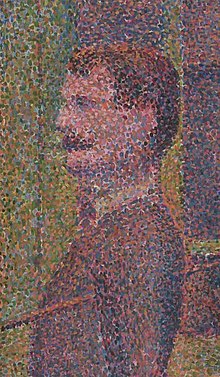Pixels, a term coined in 1965 and short for picture elements, are the smallest components of a digital image. They can only be one colour, but next to each other in their thousands or millions will blend to make a smooth image full of tones and shapes. The higher the resolution a digital image is, the more pixels are displayed and the smoother the image appears. "Bits" refer to the number of colours a pixel can possibly be. For example, 8-bit colour (ie. 2 to the power of 8) will display 256 colours, 16-bit colour (also called Highcolour; 24-bit colour's known as Truecolour) will display 65,536 colours and so on. The higher the number, the better the picture quality.
 |
| Close up of Seurat's Circus Sideshow |
Some artists have created paintings using techniques which almost imitate the aesthetic of a pixelised image. They paint their subjects in a deconstructed fashion, in lots of tiny individual components rather than blending the colours into each other. Georges Seurat, for example, was very fond of using pointilism in his paintings. The singular points of colour in their thousands make his work look grainy and almost pixelised like a digital image with a low resolution.
While Seurat wasn't aware of the similarity between his work and the pixels of a modern digital image, there are quite a few artists today who deliberately emulate the pixelated aesthetic in their work.
Chuck Close is one such artist. While he is capable of creating photorealistic images, he chooses to break his images down into hundreds of small componentes. Within each square he uses four or five colours eventually accomplishing a vibrant and unusual aesthetic in his pictures. The over effect makes me think of looking at a person through patterned glass or through the surface of disturbed water. It makes his portraits more interesting to look at by creating a sense of mystery or censorship around the subjects. It piques the viewer's interest in the person being slightly hidden from view by Close's unique style of painting.


No comments:
Post a Comment